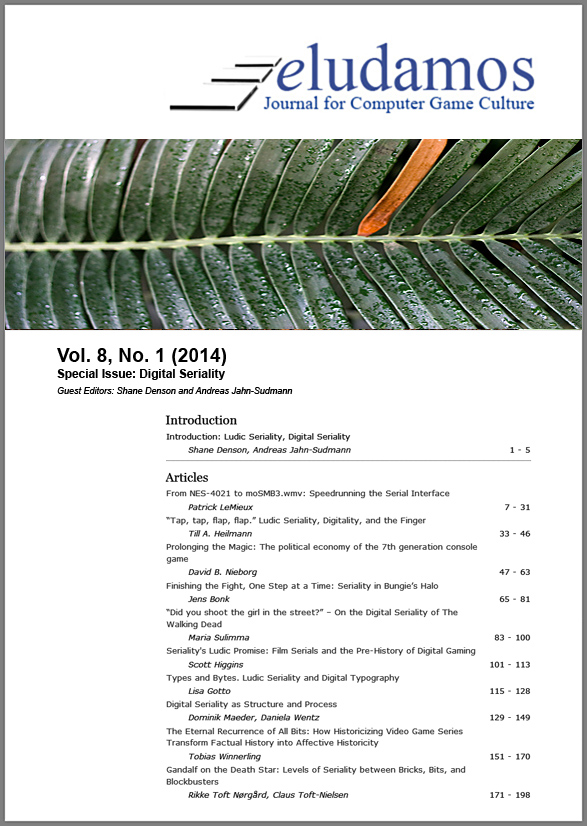Finishing the Fight, One Step at a Time: Seriality in Bungie’s Halo
DOI:
https://doi.org/10.7557/23.6156Abstract
The computer game series Halo has become one of the largest and most profitable transmedia franchises in the world, with lifetime sales of more than $3 billion in 2013 (Halo Waypoint). The narratives within the Halo universe unfold across several computer games, comic books, novels, short films (including advertising) and ARGs. On top of these corporate products that form the core ‘canon,’ fan communities have built intricately connected, additional narratives (e.g. Rooster Teeth’s Red vs. Blue) based on the story and/or the technology provided by the Halo games. This paper seeks to explore the different modes of seriality that Halo engages with. It thus traces Halo’s narrative across what Denson and Jahn-Sudmann have called “intra-ludic, inter-ludic and para-ludic” boundaries (2013). Obviously Denson and Jahn-Sudmann’s approach lends itself to the analysis of the complex fiction of Halo as a whole, but also of its constituent parts and their interrelations. As with a lot of modern transmedia franchises, Halo’s narrative universe is at the same time splintered and unified, each installment standing on its own, but also being connected to a larger, fictional history. Consequently, it represents the culmination of what Marsha Kinder first described as “transmedia intertextuality” (1993) and what Henry Jenkins has developed further in several volumes and articles (e.g. 2003, 2011). Beginning with the big picture of Halo as a transmedia universe, this paper will analyze the relationships between the different layers of seriality that make up Halo as a singular, yet disjointed, narrative. While para-ludic and inter-ludic elements of Halo’s seriality as a narrative universe are relatively obvious and clearly delineated, intra-ludic seriality within the Halo computer games is less visible and more subtle. Thus, in an effort to give a more detailed explanation of the role intra-ludic seriality plays in Halo as a whole, a large part of this paper will consist of a close reading of Halo 3’s first chapter. A central concept for this analysis will be the notion of “serial one-upmanship” or “outbidding” (cf. Jahn-Sudmann and Kelleter 2012), which is at the core of Halo 3’s intra-ludic seriality. While Halo 3 is divided into clearly marked chapters, this paper will argue that its intra-ludic seriality extends further and is shaped by elements of the gameplay itself. In order to offer a detailed analysis of these elements, Aki Järvinen’s terminology for elements of games will be employed (2007).Publication Facts
Metric
This article
Other articles
Peer reviewers
0
2.4
Reviewer profiles N/A
Author statements
Author statements
This article
Other articles
Data availability
N/A
16%
External funding
No
32%
Competing interests
N/A
11%
Metric
This journal
Other journals
Articles accepted
12%
33%
Days to publication
50
145
Indexed in
-
—
- Academic society
- N/A
- Publisher
- Septentrio Academic Publishing
Published
2014-12-12
How to Cite
Bonk, J. (2014) “Finishing the Fight, One Step at a Time: Seriality in Bungie’s Halo”, Eludamos: Journal for Computer Game Culture, 8(1), pp. 65–81. doi: 10.7557/23.6156.
Issue
Section
Articles








